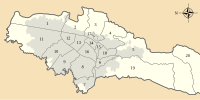Plaza de Bolívar, Bogotá
 View of Bolívar Square | |
| Native name | Plaza Bolívar (Spanish) |
|---|---|
| Former name(s) | Plaza Mayor (1539–1821) Plaza de la Constitución (1821–1846) |
| Namesake | Simón Bolívar |
| Area | 1.3903 ha (3.436 acres) |
| Location | La Candelaria, Bogotá |
| Coordinates | 4°35′53″N 74°4′34″W / 4.59806°N 74.07611°W |
| North | Calle 11 |
| East | Carrera 7 |
| South | Calle 10 |
| West | Carrera 8 |
| Construction | |
| Construction start | 27 April 1539 |
| Inauguration | 20 July 1846 |
| Other | |
| Status | National monument (19 October 1995) |
The Bolívar Square (
The history of Bolívar Square dates back to the pre-Columbian era, when the site was part of the
Bolívar Square is a main tourist attraction in La Candelaria of Bogotá and the site for various manifestations and protests.
Description

Bolívar Square is bordered by the streets Calle 10 in the south and Calle 11 in the north and Carrera 7 and Carrera 8 in the east and west respectively. The area is approximately 13,903 square metres (149,650 sq ft).[1]
Buildings
| Edge | Building | Constructed | Image |
|---|---|---|---|
| North | Palace of Justice | 1998 |
 |
| West | Liévano Palace | 1902–1905 |
 |
| South | National Capitol |
1846–1926 |
 |
| East | Primary Cathedral of Bogotá |
completed in 1823 |
 |
History
Pre-Columbian history

The history of Bolívar Square goes back to
Studies published about the
Colonial history
From the city's founding, the square was the site of a pillory, "La Picota," where public punishments were conducted for nearly a half-century. It was replaced by a public water source in 1583.[6]
During the early colonial period, the Plaza Mayor was a market square, where
The present-day Primary Cathedral on the eastern side dates from the early 19th century; construction was started in 1807 by Domingo de Petres and finished in 1823.[1]
Republican period

In the
Modern history

The
Bolívar Square was proposed as a national monument on 26 October 1994 and received that status on 19 October 1995.[11]
Bolívar Square has a long history as site for various protests. In July 1947, more than 100,000 people protested during the night.[12] During a protest in 2016, students camped on the square.[13]
Panoramas
See also
- Primary Cathedral of Bogota
References
- ^ a b c d (in Spanish) Lo que usted no conocía de la Plaza de Bolívar de Bogotá Archived 4 May 2016 at the Wayback Machine
- ^ Ocampo López, 2007, p. 226
- ^ Bonilla Romero, 2011, p. 9
- ^ Bonilla Romero et al., 2017, p. 153
- ^ a b (in Spanish) Plaza de Bolívar Archived 18 October 2016 at the Wayback Machine – Colparques
- ^ "Hitos de la plaza de Bolívar en 400 años de historia". El Tiempo. 12 July 2019. p. 3.1.
- ^ (in Spanish) Plaza de Bolívar Archived 18 January 2017 at the Wayback Machine
- ^ (in Spanish) Capitolio Nacional Archived 18 January 2017 at the Wayback Machine
- ^ Escovar, 2002, p. 69
- ^ (in Spanish) Palacio de Justicia Archived 18 January 2017 at the Wayback Machine
- ^ (in Spanish) Decreto número 1802 de 1995 (octubre 19) – Declaración Monumento Nacional, Inmuebles representativos de la arquitectura moderna en Colombia Archived 18 January 2017 at the Wayback Machine
- ^ (in Spanish) El día en que mataron a Gaitán Archived 18 January 2017 at the Wayback Machine – Banco de la República
- ^ (in Spanish) Jóvenes acampan indefinidamente en Plaza de Bolívar para pedir que salven acuerdo con Farc Archived 18 January 2017 at the Wayback Machine – El Espectador
Bibliography
- Bonilla Romero, Julio H.; Bustos Velazco, Edier H.; Duvan Reyes, Jaime (2017). "Arqueoastronomía, alineaciones solares de solsticios y equinoccios en Bogotá-Bacatá – Archaeoastronomy, alignment solar from solstices and equinoxes in Bogota-Bacatá". Revista Científica, Universidad Distrital Francisco José de Caldas. 27: 146–155. Retrieved 10 January 2017.
- Bonilla Romero, Julio H (2011). "Aproximaciones al observatorio solar de Bacatá-Bogotá-Colombia – Approaches to solar observatory Bacatá-Bogotá-Colombia". Azimut, Universidad Distrital Francisco José de Caldas. 3: 9–15. Retrieved 10 January 2017.
- Escovar, Alberto W. (2002). Bogotá: Historic Center. Ediciones Gamma S.A. p. 69. Retrieved 10 January 2017.
- ISBN 978-958-14-0368-4.





